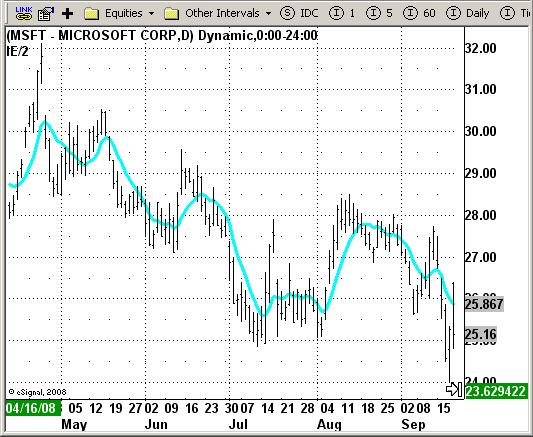File Name: IE2.efs
Description:
IE/2
Formula Parameters:
Length: 15
Price Data To Use: Close
Notes:
IE/2 is one of pre-studies created while T3 famous average was developing.
It is calculated as (ILRS(n)+EPMA(n))/2.
ILRS, is an integral of linear regression slope. In this moving average,
the slope of a linear regression line is simply integrated as it is fitted
in a moving window of length n across the data. The derivative of ILRS is
the linear regression slope.
EPMA is an end point moving average - it is the endpoint of the linear regression
line of length n as it is fitted across the data. EPMA hugs the data more closely
than a simple or exponential moving average of the same length.
Download File:
IE2.efs

EFS Code:
Description:
IE/2
Formula Parameters:
Length: 15
Price Data To Use: Close
Notes:
IE/2 is one of pre-studies created while T3 famous average was developing.
It is calculated as (ILRS(n)+EPMA(n))/2.
ILRS, is an integral of linear regression slope. In this moving average,
the slope of a linear regression line is simply integrated as it is fitted
in a moving window of length n across the data. The derivative of ILRS is
the linear regression slope.
EPMA is an end point moving average - it is the endpoint of the linear regression
line of length n as it is fitted across the data. EPMA hugs the data more closely
than a simple or exponential moving average of the same length.
Download File:
IE2.efs

EFS Code:
PHP Code:
/*********************************
Provided By:
eSignal (Copyright c eSignal), a division of Interactive Data
Corporation. 2008. All rights reserved. This sample eSignal
Formula Script (EFS) is for educational purposes only and may be
modified and saved under a new file name. eSignal is not responsible
for the functionality once modified. eSignal reserves the right
to modify and overwrite this EFS file with each new release.
Description:
IE/2
Version: 1.0 09/23/2008
Notes:
IE/2 is one of pre-studies created while T3 famous average was developing.
It is calculated as (ILRS(n)+EPMA(n))/2.
ILRS, is an integral of linear regression slope. In this moving average,
the slope of a linear regression line is simply integrated as it is fitted
in a moving window of length n across the data. The derivative of ILRS is
the linear regression slope.
EPMA is an end point moving average - it is the endpoint of the linear regression
line of length n as it is fitted across the data. EPMA hugs the data more closely
than a simple or exponential moving average of the same length.
Formula Parameters: Default:
Length 15
Price Data To Use Close
**********************************/
var fpArray = new Array();
var bInit = false;
function preMain()
{
setStudyTitle("IE/2");
setCursorLabelName("IE/2");
setDefaultBarFgColor(Color.cyan, 0);
setPlotType(PLOTTYPE_LINE,0);
setDefaultBarThickness(3, 0);
setPriceStudy(true);
var x=0;
fpArray[x] = new FunctionParameter("Length", FunctionParameter.NUMBER);
with(fpArray[x++]){
setLowerLimit(1);
setDefault(15);
}
fpArray[x] = new FunctionParameter("Price", FunctionParameter.STRING);
with(fpArray[x++]){
setName("Price Data To Use");
addOption("open");
addOption("high");
addOption("low");
addOption("close");
addOption("hl2");
addOption("hlc3");
addOption("ohlc4");
setDefault("close");
}
}
var xIE = null;
var xMyPrice = null;
function main(Price, Length) {
var nIE = 0;
if (Price == null) Price = "close";
if (Length == null) Period = 15;
if ( bInit == false ) {
xMyPrice = eval(Price)();
xIE = efsInternal("Calc_IE", xMyPrice, Length);
bInit = true;
}
if (getCurrentBarCount() <= Length) return;
nIE = xIE.getValue(0);
return nIE;
}
function Calc_IE(xMyPrice, Length){
var nAvg = 0.0;
var nSumBars = Length * (Length - 1) * 0.5;
var nSumSqrBars = (Length - 1) * Length * (2 * Length - 1) / 6;
var nSum1 = 0.0;
var nSumY = 0.0;
for (var i = 0; i < Length; i++)
{
nAvg += xMyPrice.getValue(-i);
nSum1 += i * xMyPrice.getValue(-i);
nSumY += xMyPrice.getValue(-i);
}
nAvg /= Length;
var nSum2 = nSumBars * nSumY;
var nNum1 = Length * nSum1 - nSum2;
var nNum2 = nSumBars * nSumBars - Length * nSumSqrBars;
var nLinRegSlope = 0.0;
if (nNum2 != 0)
{
nLinRegSlope = nNum1 / nNum2;
}
var nILRS = nLinRegSlope + nAvg;
var nIntercept = (nSumY - nLinRegSlope * nSumBars) / Length;
var nLinearRegValue = nIntercept + nLinRegSlope * (Length - 1);
var nIE = (nILRS + nLinearRegValue) / 2;
return nIE;
}